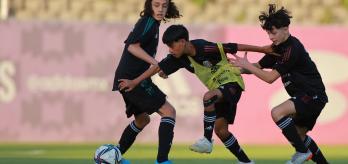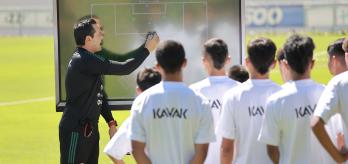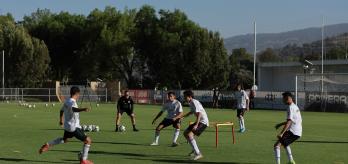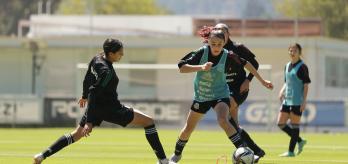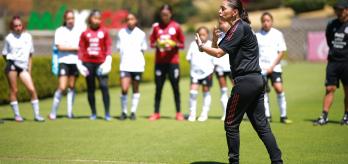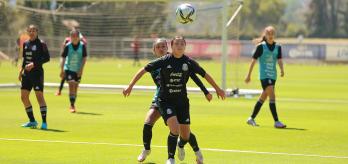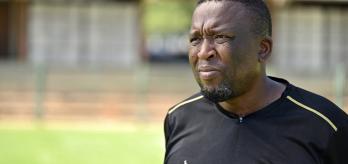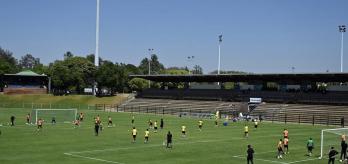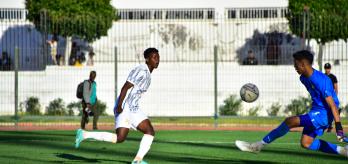Knowing how to counter-press coherently as a team is a critical strategy and should be implemented at a young age. By understanding factors such as press coverage, having the nearest player to the ball press first and pressing immediately after losing the ball, a team can maintain a compact structure and be well prepared should the first line of the press be evaded. It also significantly increases their chances of suffocating the opposition and winning the ball back within seconds so that they maintain prosperous attacking situations.
In this session, Mexico U15 head coach Cristian Flores and assistant coach Adrián Sánchez run through some exercises that help young players to understand the importance of immediately winning the ball back after an attack breaks down. The session starts with Adrián Sánchez, who presents the players with a 5v2 rondo drill in tight spaces. The session finishes with Cristian Flores, who delivers an 8v8 exercise in which players have to press with intensity and win the ball high up the pitch.
Session overview
Key coaching points
This exercise requires a total of 24 players and two goalkeepers. The rondo exercises may be adjusted to fit a 6v2 scenario instead.
-
After a loss of possession, players must adjust their mentality immediately to win the ball back, with the player who lost the ball being the first to implement the press.
-
The team pressing to win the ball back should try to do so within 3-4 opposition passes and prevent the opposition from progressing the ball into a dangerous area.
-
By pressing quickly, and as a unit, the defending team can maintain their attacking structure with players still occupying good attacking positions and being close to the opposition’s goal.
-
The pressing team should suffocate the opposition and prevent them from having time to think or space to work when they try to construct from the back.
-
The player who loses the ball should be the first to press and try to recover the ball. The supporting teammates should follow coherently and block off any potential passing lanes.
-
A compact defensive structure behind the counter-press ensures that players are close together and less distance is involved when trying to recover the ball.
This session was designed with a real-game scenario in mind and aims to answer questions such as; How to increase the chances of winning the ball back quickly? And how to counter-press in numbers?
Part 1: 5v2 rondo
Adrián Sánchez leads the first session, which aims to provide players with the correct mindset when trying to counter-press. Rondos are one of the most effective exercises for instilling this mindset, as they show players the approach of switching actions from being in possession to hunting the ball down quickly. By working together as a team and focusing on intensity, the press can be applied efficiently and the ball can be recovered quickly.
-
Mark out a 10x10m area.
-
Position a triangle goal in the centre of the area (use three cones if not possible).
-
Position 5 players around the edges of the area.
-
Position 2 players in front of the triangle goal.
-
The 5 players around the edges of the area have to circulate the ball.
-
These 5 players are limited to 2 touches each.
-
The 2 defenders have to press, follow the ball carrier and try to win the ball back.
-
If the attacking team successfully passes through the triangle goal, they score 1 point.
-
The defenders have to prevent the pass from going through the triangle goal.
-
The player who loses the ball, and the player on their right, go into the middle and swap with the 2 defenders, who now join the attacking team.
-
The players should switch roles immediately so that the press is effective.
-
When pressing, 1 defender should close down the player with the ball whilst the second defender should diagonally cover the passing angle inside to make it harder for the team in possession to play through the triangle or between themselves.
-
The defenders cannot allow the opposition to penetrate the defensive line (play a pass between them).
-
The players pressing should not just protect the area around the goal as they will simply accompany the ball rather than recover it. The objective is to win the ball at all costs.
-
The second defender should be able to read the situation and guide their team-mate where to press and when to switch the cover.
-
The speed of approach is a vital component in recovering the ball immediately. By getting out to opposing players quickly, they can force more errors.
-
Intensity should be at the forefront of players' minds as this can determine the efficiency of their actions in a real-game situation.
Part 2: 8v8 – counter-pressing game
Cristian Flores finishes the session with a game that is aimed at raising the intensity of a team's press when recovering the ball. A cohesive and collective press can be key to winning the ball back quickly and in an advantageous position on the pitch, leading to more goalscoring opportunities. The exercise also shows players how to remain in a compact structure when counter-pressing high whilst offering effective coverage for their team-mates.
-
Mark out a 40x50m area inside one half of a pitch.
-
Split the area into 2x20m zones at either end with a 10m zone in the centre.
-
Position 2 full-size goals at either end.
-
Position a goalkeeper in each of the goals.
-
Divide the outfield players into 3 teams of 8.
-
2 teams start on the pitch in an 8v8 scenario.
-
The third team waits at the side of the pitch.
-
The ball starts or restarts with a goal kick for each game.
-
The team in possession has to build from the back and at the same time move up the pitch as a unit.
-
As the team in possession are progressing through the thirds, their entire unit should have crossed the line into the central zone and then look to maintain this position.
-
All of the team’s players must have crossed the line into the central zone before they can score a goal otherwise the goal does not count.
-
If the team in possession loses the ball in the final third, the entire unit has to counter-press and look to win the ball back immediately.
-
The team out of possession has to press the opposition high and prevent them from building an attack.
-
If a team loses possession inside the final third, successfully wins it back immediately inside this zone and then goes on to score, they score 4 points.
-
Every game is over after a goal is scored or after 2 minutes. When a goal is scored, the team who conceded leaves the pitch and the third team has 5 seconds to get onto the pitch and start play.
-
Play should start with the team that have just entered the pitch.
-
Play for 20-25 minutes depending on the intensity performed by the players.
-
Encourage the players to build up play within a clear structure. The centre-backs should split and the defensive midfielder drops into space, whilst the other midfielders and attackers should find pockets of space to open up passing lanes.
-
Once a team progresses the ball into the final third they should look to stay in this position and stay compact at the same time.
-
The press starts with the forward players, who should be aggressive and try to win the ball back immediately so that they can take advantage of being close to the opposition’s goal.
-
If the team that has just lost possession are unable to win the ball back within 3-4 passes, they should fall back and stay compact to make it hard for the opposition to play through.
-
The player who loses the ball or who is closest to the ball should always press first. Thus, their teammates must recognise when and whom to cover at all times.
-
Ensure that players are playing and defending with maximum intensity so that they can easily adjust their approach in the transition and hunt the ball down as soon as they lose it.



